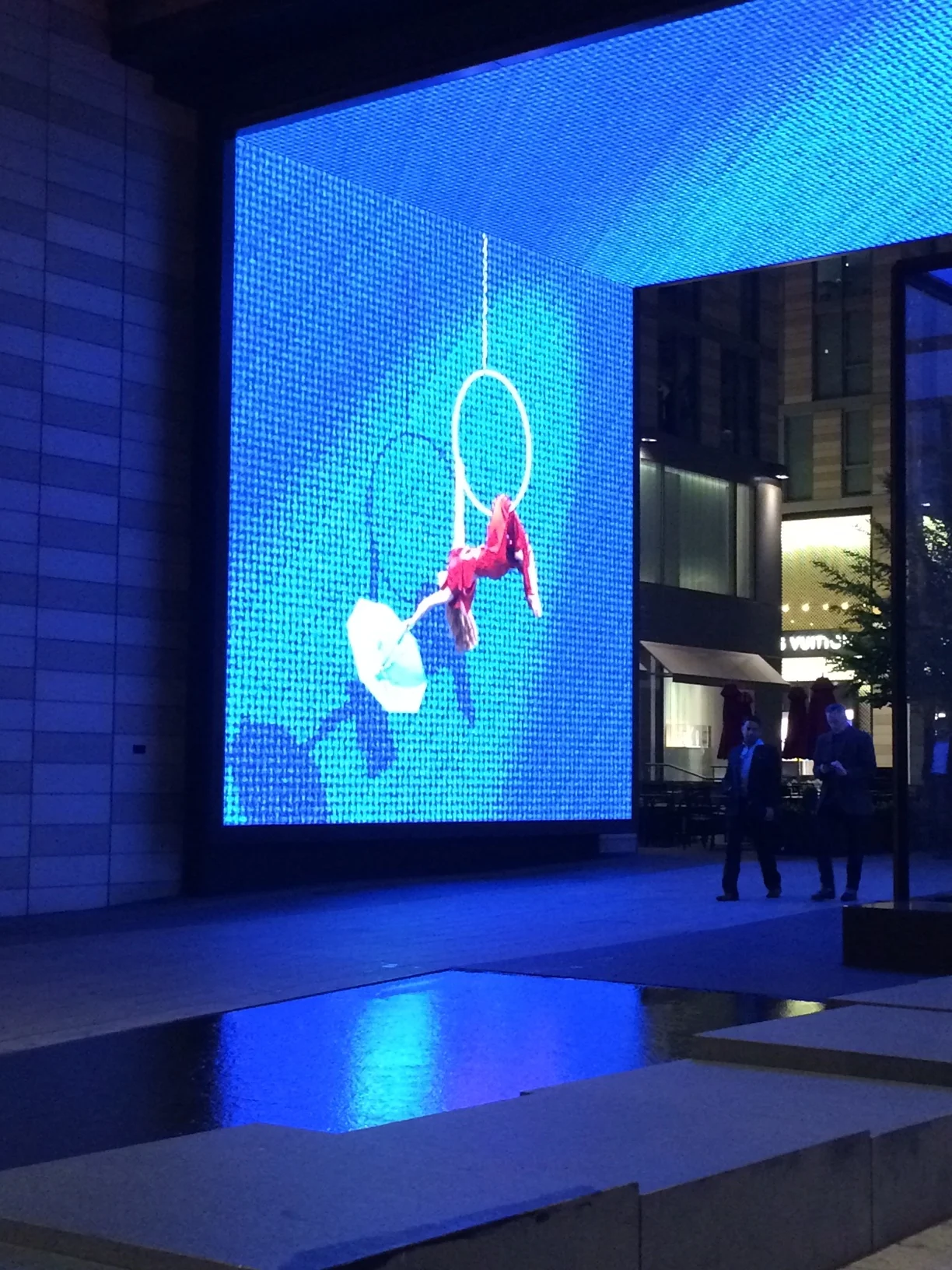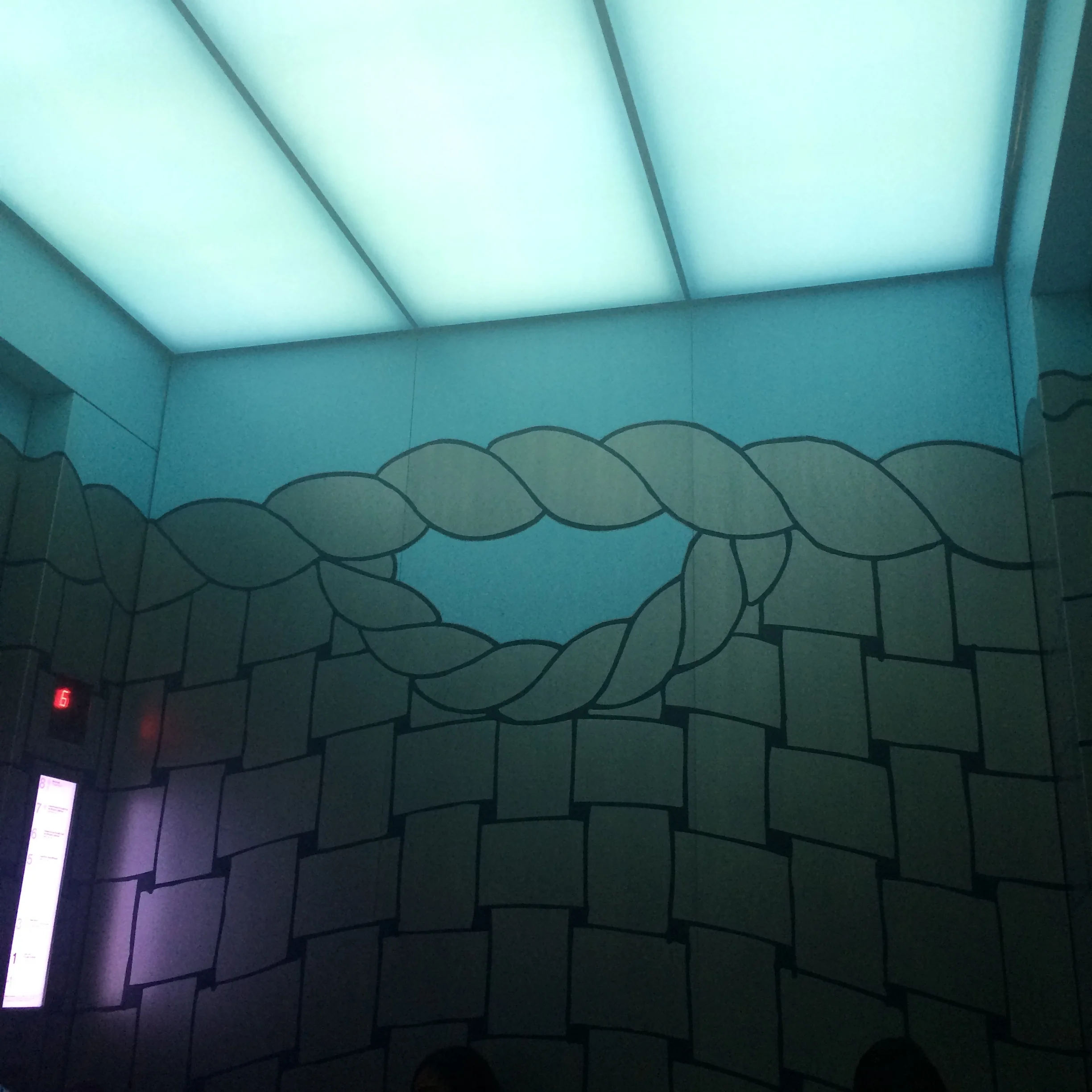Percieved Materials: Tales of Kinetic Light Art and Liquid Marble
It was dark, and late. We were walking, weaving our way through CityCenterDC –a massive development in the heart of the nation’s capital. Chic restaurants, multiple rows of high-end retail, a spacious outdoor plaza, and then my gaze stopped at something.
I was in front of a monumental gateway constructed of light. And there was nothing ordinary about this portal.
Dynamic, kinetic, ephemeral and yet tangible – all at once. I watched as millions of minuscule LED lights transformed the three large planes of light and imagery, from static stone paving to flowing water, to a moving vignette of a dancer.
Flowing Water –The first spotted avatar of the Gateway at CityCenterDC, Washington DC.
Over 50 feet in width and 25 feet high, this was the most captivating sight I had seen in years. I felt transfixed, like a child. I refused to move till I had seen more, watch the 'screens' (for lack of a better word) transform again and dazzle me. How often does design, art or architecture make us feel like this?
Read on to learn about two installations that challenged the definition of what I call 'materials' and made for spectacular visual experiences.
PART 1: Kinetic LED Art can simulate real materials and tactile experience.
The Natural stone paving pattern recreated by the LEDs.
The large LED lit portal I encountered was a Kinetic Art Installation known as ‘The Gateway at CityCenterDC.' Media Artist David Niles, of the Niles Creative Group designed this immersive experience to be at the core of a 12-Acre mixed-use development in the center of downtown Washington DC.
The installation receives input from a content delivery system run by Artificial Intelligence. The system feeds animated vignettes shot by Niles and Computer Generated Imagery to the array of LEDs. The three-dimensional imagery reproduced onto the LEDs responds to the time of day and occasionally to seasonal events. While cutting-edge technology is clearly the driving force here, what makes this installation an unparalleled visual experience is the perceptions it creates for the viewer. Here’s how it struck a chord with me:
1) Stone paving created from light: As the LED screens transformed continuously, at one point all three planes of light took the form of stone paving. Standing 50 feet away, I could see the specs of natural stone; I could sense the coarseness and texture of a real stone slab. Creating perceived material where none exists, in reality, is no small feat.
2) Tactile Draw: Something about the selection of source imagery and its three-dimensional recreation on a sea of LEDs, pulls in people like me to touch. I found myself helplessly walking closer to the LEDs –Wanting to understand what was going on behind those lights, wanting to feel something. Foolish me. And what an incredibly successful design. The best design draws people in, inviting them to have a tactile experience and form memories.
3) No promotions, No Ads: Light screens are typically preyed on and monopolized by advertisements and promotions. None of that here. Just a pure visual feast for your eyes, with no hidden agenda. How refreshing.
Three dimensional Vignettes appearing on the LED Screens.
Sidebar: LED Art has existed since the 2000's, and designers like Leo Villareal, Jim Campbell, and Jenny Holzer have created many compelling installations using LEDs. In fact, on this very same trip to DC, I made my third visit to the National Gallery of Art, only to be enthralled by Villareal's 'Multiverse' walkway yet again. It needs to be said, though, that while Multiverse is a spectacular feat of design and technology; it did not alter my perception of materials the way Gateway to CityCenterDC did.
PART 2: 'Liquid Marble', He said.
That night, perched on my hotel room bed in Georgetown, I couldn’t stop thinking about the large pattern of stone created by LEDs that I had seen earlier. My mind was drifting and coining a term of its own –‘perceived materials’.
While I was lingering over this idea of elements that exist primarily in our perception –crafted with tools like light and technology, I chanced upon something in my Instagram newsfeed. Dezeen magazine had shared an image of an installation-’Petite Loire’ by French Designer Mathieu Lehanneur. The installation was a giant green swathe of ‘Liquid Marble’ for the Courtyard of Domaine de Chaumont-sur-Loire Centre d’Arts et de Nature in France.
And what exactly is ‘Liquid Marble’ you ask?
Lehanneur’s ‘Liquid Marble’ is a solid piece of green marble –Shaped, and hand polished, guided by 3-D software so as to reproduce the effect of wind blowing over the surface of the water. The intent? –To capture that ephemeral dynamic movement of water into something as solid and static as marble. The result is beautiful and convincing.
Can you imagine the possibilities? Resilient, durable marble acting as the understudy for a water body somewhere –perhaps in drought-prone areas– and doing just as well. 'Liquid Marble' bringing the qualities and effects of water and liquids indoor spaces where we couldn’t go before. A cost- effective, static solution with a dynamic impact.
Part 3: Closing out
Interfacing with these two installations allowed me to expand my vocabulary of materials and even redefine what ‘material’ has to be. LED's and Computer-Generated Imagery now qualifies as a design tool and building material for me. By embracing the technologies discussed above, we can be more dynamic with the base materials we create and employ in design, without losing out on the tactile and tangible qualities we seek.










